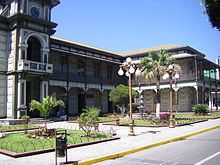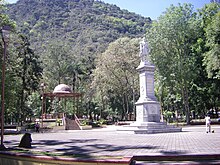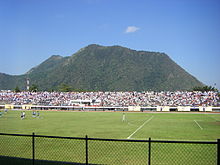Orizaba
| Orizaba | ||
|---|---|---|
|
Coordinates: 18 ° 51 ′ N , 97 ° 6 ′ W Orizaba on the map of Veracruz
|
||
| Basic data | ||
| Country | Mexico | |
| State | Veracruz | |
| Municipio | Orizaba | |
| Residents | 120,844 (2010) | |
| City insignia | ||
| Detailed data | ||
| height | 1236 m | |
| prefix | 272 | |
| Website | ||
| Street in Orizaba | ||
Orizaba is a city in the Altas Montañas region in the Mexican state of Veracruz . The city has a population of 120,844 (2010 census). Orizaba is the administrative seat of the Municipio Orizaba and the seat of the Diocese of Orizaba .
The city, located 1236 meters above sea level in an extraordinarily fertile valley, is surrounded by several mountains, of which the Citlaltépetl volcano, better known as Pico de Orizaba in colloquial language, is also the highest mountain in Mexico at 5,636 meters.
Road structure
The main axes of the city are the Madero and Colón streets , which also determine the classification system of the other streets. Their meeting at Parque Castillo forms the starting point of both main axes. From here, Calle Madero runs under the name Calle Madero Norte in the north and as Calle Madero Sur to the south. The Avenida Colón as the east-west axis of the city runs from this intersection in a westerly direction as Avenida Colón Poniente and as Avenida Colón Oriente to the east.
The other streets have corresponding designations that allow easy orientation. All streets running from west to east are called Avenida Poniente to the west of Calle Madero and Avenida Oriente to the east . The streets running from north to south are called Calle Norte north of Avenida Colón and Calle Sur south of this ; d. H. all streets running from east to west are referred to as "Avenida" and all streets running from north to south as "calle".
In the northwest sector, the streets called Avenida Poniente always have an even number (from south to north ascending first Avenida Poniente 2 , then Avenida Poniente 4 , and so on) and in the southwest sector an odd number: from north to south ascending the Avenida Poniente 3 , Avenida Poniente 5 and so on. In the northeast sector you will find the streets called Avenida Oriente with the odd numbers (from south to north ascending first Avenida Oriente 3 , then Avenida Oriente 5 , and so on) and in the southeast sector those with the even numbers: from north to South ascending Avenida Oriente 2 , Avenida Oriente 4 and so on.
In the same way, the streets called Calle Norte and Calle Sur differ . In the northwest sector there is Calle Norte 3 , Calle Norte 5 , and so on (ascending from east to west) and in the northeast sector is Calle Norte 2 , Calle Norte 4 , and so on (ascending from west to east). In the south-western sector there are Calle Sur 2 , Calle Sur 4 and so on (ascending from east to west) and in the southeast sector there is Calle Sur 3 , Calle Sur 5 and so on (ascending from west to east).
Calle Madero Norte
Calle Madero , named after the former President Francisco Madero , runs north from Avenida Colón as Calle Madero Norte . Right at the beginning of its route, it leads past Parque Castillo, northeast of the intersection, and then past the cathedral located between the streets Poniente 2 and Oriente 3 . To the west of the street, on the area between Avenida Poniente 2 and Avenida Poniente 4 , is the Palacio de Hierro , where the town hall was located until 1990.
The Calle Norte Madero extends in the north to the coincidence of the Avenida Poniente 34 with the Avenida Oriente 35 where it is interrupted at a property which until Avenida Oriente 39 extends. To the north of this the street continues to Avenida Oriente 43 . In the area north of Poniente 34 , Calle De Norte 3 to the west of the property forms the border between Avenidas Poniente and Oriente .
Calle Madero Sur / Carretera Federal 150
South of Avenida Colón extends the Calle Madero Sur "only" up to the Avenidas Poniente 9 and Oriente 10 . One block north of this, it crosses the city freeway , which as part of Carretera Federal 150 connects the Mexican capital with the port city of Veracruz . The cities of Puebla (west of Orizaba) and Córdoba (east of Orizaba) are also on the route . Within the city limits of Orizaba, Carretera Federal west of Calle Madero Sur is referred to as Avenida Poniente 7 and east of Madero Sur as Avenida Oriente 6 . It used to be known in the inner city as Calle Real and in the region as Camino Nacional . It is the most important artery in the city for car and bus traffic.
Avenida Colón
The street is named after the Spanish name Cristóbal Colón for Christopher Columbus . To the west of the intersection with Calle Madero , Avenida Colón Poniente runs to the Alameda Park "Francisco Gabilondo Soler" , behind which the historic Cerro del Borrego rises. On this 500 meter long section, the street leads past the Palacio Municipal to the south (entrance opposite Calle Norte 7 ), where the city hall has been located since 1991.
To the east of the intersection with Calle Madero and immediately south of Parque Castillo , Avenida Colón Oriente leads east to the north side of the Juan de la Luz Enríquez municipal cemetery and ends at Calle Sur 47 . On the north side of the street are among other things the municipal library José Bernardo Couto Pérez (between Calle Norte 18 and Calle Norte 22 ), the covered bullring Plaza de Toros La Concordia de Orizaba , which is also used as a municipal event hall, with an entrance in Avenida Poniente to the north 5 (between Calle Norte 36 and Calle Norte 38 ) and the Centro de Rehabilitación Integral de Orizaba, north of the cemetery (between Calle Circunvalación and Calle Norte 44 ).
history
The name Orizaba developed from the word Ahuilizapan , which the pre-Hispanic settlers gave the place. This comes from the Nahuatl language and roughly means place of the water features or place of lively waters and is derived from the abundant rivers. In fact, Orizaba is one of the most riverbed cities in Mexico. It is located in a hydrographic basin of the Río Papaloapan . The fertile soil of this city is supplied by numerous rivers, most of which are tributaries of the Río Blanco . The most important bodies of water in the city of Orizaba are the Río Orizaba of the same name and the Río Blanco itself. In addition to its connection to the Mexican rail network at the end of 1872, Orizaba owes its rise to an industrial city above all to the abundant bodies of water in the region. In the 1880s and 1890s, for example, a number of factories were established that generated energy from the hydropower of the two local rivers. The course of the Río Orizaba, which flows through the city from north to south, required a series of bridges to connect the western and eastern urban areas. They gave the city its nickname La señora de los puentes ( Eng . The woman of the bridges ).
With the arrival of the Spaniards, the importance of the rapidly growing settlement increased. The main reason for this was its exposed location on the connection route between the Mexican capital Mexico City and the country's most important port, Veracruz .
When tobacco cultivation was accelerated here in 1764, another boom set in. Orizaba received town status in 1830 and early industrialization began in 1836 with the opening of the first factory. In 1874 Orizaba was even declared the capital of the state of Veracruz, but lost this status in 1878 to the city of Xalapa , which has remained the capital to this day. The first stylish town hall was the Palacio de Hierro, which was shipped from Brussels in Belgium to Orizaba in 1894 . In 1896, Cervecería Moctezuma, one of the most important breweries in Mexico, was founded in Orizaba .
Soccer
The early industrialization of the city led, among other things, to the establishment of two football clubs, both of which were founding members of the Primera División , the top division of Mexican club football , introduced in 1943/44 .
The older Asociación Deportiva Orizabeña, whose club crest shows the Pico de Orizaba , was founded by Scottish textile workers in 1898 (at that time still under the name Orizaba AC) and can boast of being the first champion (1903) in the history of Mexican football. His first team last played in the 2010/11 season under the name Albinegros de Orizaba in the second-rate Liga de Ascenso .
The other association was founded in 1932 by employees of the aforementioned brewery under the name Union Deportiva Moctezuma de Orizaba . The logo of the association, which no longer exists today, was identical to the city arms.
The city also produced a number of football talents who were the pillars of the capital city of America in the 1920s and 1930s . These include primarily the brothers Ernesto , Isidoro and Jorge Sota , who all made it into the Mexican national soccer team. These include the brothers Luis and Hesíquio Cerrilla, Juan and Rosendo Terrazas and Alfredo "Viejo" Sánchez .
The brothers José , Martín and Samuel Cuburu , born in Orizaba in the 1920s, were soccer players who all played in the Mexican professional league introduced in 1943/44. Before the introduction of professional football, Martín Cuburu was twice champion with Real Club España and Samuel Cuburu was part of the Mexican World Cup squad in 1950 .
Attractions

- Castillo Mier y Pesado
- Catedral de San Miguel Arcángel
- Iglesia de la Concordia
- Museo de Arte del Estado
- Palacio de Hierro
- Palacio Municipal
- Panteón Juan de la Luz Enríquez
- Plaza de la Constitución
- Teatro Llave
- Templo y Exconvento del Carmen
There are also a few sights just outside the city .
Persons connected to Orizaba
sons and daughters of the town
Died in Orizaba
The persons listed below are sorted in chronological order according to the year of death.
- Rafael Delgado († 1914), Mexican writer
- Miguel Torruco († 1956), Mexican actor
- Ernst Pauler († 1959), Austrian football player and coach
- Evaristo Murillo († 2005), Costa Rican soccer player and coach
Individual references and sources
- ^ Catálogo de Localidades
- ↑ Winston Crausaz: Pico de Orizaba or Citlaltepetl. Geology, Archeology, History, Natural History, and Mountaineering Routes; with additional material on the high Mexican volcanoes . Amherst, Ohio, Geopress Boarding School. 1993, ISBN 1-884681-50-6 .
- ↑ Monografias.com: Orizaba Veracruz (Spanish; accessed December 29, 2013)
- ↑ Official website of the state of Veracruz: Pico de Orizaba ( page no longer available , search in web archives ) Info: The link was automatically marked as broken. Please check the link according to the instructions and then remove this notice. (Spanish; accessed December 29, 2013)
- ↑ Eulalia Ribera Carbó / Instituto Mora: Orizaba y las fiestas del Centenario (Spanish; accessed December 29, 2013)
- ↑ Mauricio R. Vidal: Orizaba, La señora de los puentes ( Memento of the original from March 13, 2014 in the Internet Archive ) Info: The archive link was inserted automatically and has not yet been checked. Please check the original and archive link according to the instructions and then remove this notice. (Spanish; accessed December 29, 2013)
- ↑ Juan Cid y Mulet: Libro de Oro del Fútbol Mexicano (Mexico City: B. Costa Amica, 1961), p. 298ff
- Enciclopedia de los Municipios y Delegaciones de México: Orizaba (Spanish)
- The State of Veracruz . Ediciones Nueva Guía, Madrid 2002, ISBN 968-5437-28-9 , p. 137
Web links
- Ayuntamiento Constitucional de Orizaba Official Website (Spanish)
- Monografias.com: Orizaba, Veracruz Unofficial website (Spanish)






